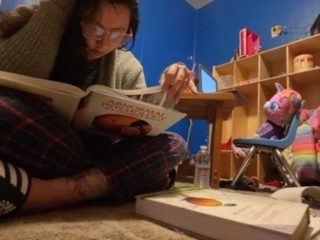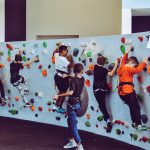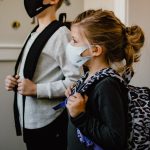Photo by Katherine Iverson
By Chelsea Hendrix
Adjusting to online learning is challenging but it can be an even greater challenge when you have children at home, some of whom are adjusting to online learning themselves. At Skagit Valley College, some students are also parents themselves trying to balance their education with their children’s. As hard as it is for many to adjust to remote learning for adults, trying to get children to adjust to sitting in front of a screen and pay attention for long periods may feel next to impossible. That is why some schools have started to bring children back into the classrooms. Though it is hard to say at this point how long it will take for schools to reopen fully, for now many families will need to continue their distanced learning in proximity.
For some SVC students remote learning is a blessing in disguise, giving the opportunity to work on their studies at home during the most convenient times. Working from home may also be a double-edged sword for some parents, never truly having enough of one’s own time and space to focus. Recent SVC graduate Paula Gunning explains, “attending school in person would allow me more time to get schoolwork done and being able to focus. But the commute would be challenging and having childcare would be challenging. Remote learning has its pros and it’s cons, but I feel remote learning was the best choice for a person in my particular situation.”
SVC student Lyndsay Oost. “I’ve always taken online classes when available, but it was a shift having to do my work plus help my daughter. It’s been okay, some weeks are better than others. It’s definitely a rollercoaster”. While everyday life with children in the home is sporadic as it is, remaining a student while parenting gives remote learning an appealing take, though weighing in with it’s own inherent perks and setbacks.
Though the advantage of remote learning has proven to be successful for some parents, it has become a struggle for others trying to balance the needs of their children’s education with their own education goals. Nursing student Nikki Estrada, “In the last couple months, I have been putting their schoolwork above my own. I stay up until 1 or 2 in the morning trying to complete my work. Last quarter, it was suggested that I withdraw from one of my classes so that I wouldn’t fail both. I was not told how this would affect my financial aid and I am now no financial aid warning. If I do not satisfy the academic progress, I will have to pay for my next quarters tuition out of pocket.” For students like Estrada prioritizing their children can have difficult consequences.
Having students in the classroom means taking new precautions when it comes to the spread of germs in the classroom. According to elementary teacher Lorena Ahola in Lake Stevens, this means for students and parents at her school, “Parents are required to do a daily health attestation form. Children are temperature checked as they enter building. A child cannot have any symptoms (not even a runny nose) in our classrooms. A negative covid-19 test plus 72 hours after last symptom is gone is required for coming back to school. Classrooms are in pods now and if there is an exposure pods go remote for a minimum of 14 days. Children never see or mingle with kids outside their classrooms. Parents have been encouraged to transport their children. If a child rides bus, they sit alone and distanced and windows are open, so kids need to dress warm. We shortened our days so we could sanitize all surfaces and learning materials between sessions. I usually have 1 assistant I have 4 now. I also have 2 classrooms so I can distance children. No adults outside staff are allowed in building.” Before the spread of covid-19 these measures might have seemed extreme, but these precautions maybe come standard practice for schools as children start returning to classrooms.
SVC students with school aged children might therefore be wondering when and how will schools start to reopen. Though many schools remain closed, some are implementing hybrid models or shortened class schedules. Aloha explained, “We welcomed students back in early October after being remote since March 15 2020.” Though many parents are happy to have their children returning to classrooms others are still cautious. Estrada, “because I work in healthcare, I opted to not have my kids return to in person learning. Even with all these difficulties that we are having, I still feel that their health is the main priority. Until this pandemic is a little more under control, I will not be sending them back to school.” As school districts still decide when and how to resume in class teaching, safety may feel remote but classrooms may be the best options for some.






